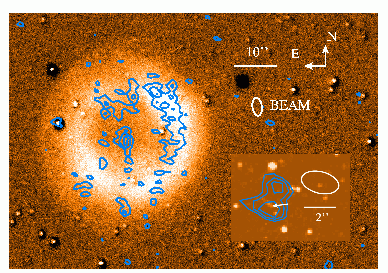April 7, 2005
Contact:
Dave Finley, Public Information Officer
Socorro, NM
(505) 835-7302
dfinley@nrao.edu
Old Star's "Rebirth" Gives Astronomers Surprises
Astronomers using the National Science Foundation's Very Large Array (VLA) radio telescope are taking advantage of a once-in-a-lifetime opportunity to watch an old star suddenly stir back into new activity after coming to the end of its normal life. Their surprising results have forced them to change their ideas of how such an old, white dwarf star can re-ignite its nuclear furnace for one final blast of energy.

Color image shows nebula ejected thousands of years ago. Contours indicate radio emission. Inset is Hubble Space Telescope image, with contours indicating radio emission; this inset shows just the central part of the region. CREDIT: Hajduk et al., NRAO/AUI/NSF, ESO, StSci, NASA |
Computer simulations had predicted a series of events that would follow such a re-ignition of fusion reactions, but the star didn't follow the script -- events moved 100 times more quickly than the simulations predicted.
"We've now produced a new theoretical model of how this process works, and the VLA observations have provided the first evidence supporting our new model," said Albert Zijlstra, of the University of Manchester in the United Kingdom. Zijlstra and his colleagues presented their findings in the April 8 issue of the journal Science.
The astronomers studied a star known as V4334 Sgr, in the constellation Sagittarius. It is better known as "Sakurai's Object," after Japanese amateur astronomer Yukio Sakurai, who discovered it on February 20, 1996, when it suddenly burst into new brightness. At first, astronomers thought the outburst was a common nova explosion, but further study showed that Sakurai's Object was anything but common.
The star is an old white dwarf that had run out of hydrogen fuel for nuclear fusion reactions in its core. Astronomers believe that some such stars can undergo a final burst of fusion in a shell of helium that surrounds a core of heavier nuclei such as carbon and oxygen. However, the outburst of Sakurai's Object is the first such blast seen in modern times. Stellar outbursts observed in 1670 and 1918 may have been caused by the same phenomenon.
Astronomers expect the Sun to become a white dwarf in about five billion years. A white dwarf is a dense core left after a star's normal, fusion-powered life has ended. A teaspoon of white dwarf material would weigh about 10 tons. White dwarfs can have masses up to 1.4 times that of the Sun; larger stars collapse at the end of their lives into even-denser neutron stars or black holes.
Computer simulations indicated that heat-spurred convection (or "boiling") would bring hydrogen from the star's outer envelope down into the helium shell, driving a brief flash of new nuclear fusion. This would cause a sudden increase in brightness. The original computer models suggested a sequence of observable events that would occur over a few hundred years.
"Sakurai's object went through the first phases of this sequence in just a few years -- 100 times faster than we expected -- so we had to revise our models," Zijlstra said.
The revised models predicted that the star should rapidly reheat and begin to ionize gases in its surrounding region. "This is what we now see in our latest VLA observations," Zijlstra said.
"It's important to understand this process. Sakurai's Object has ejected a large amount of the carbon from its inner core into space, both in the form of gas and dust grains. These will find their way into regions of space where new stars form, and the dust grains may become incorporated in new planets. Some carbon grains found in a meteorite show isotope ratios identical to those found in Sakurai's Object, and we think they may have come from such an event. Our results suggest this source for cosmic carbon may be far more important than we suspected before," Zijlstra added.
The scientists continue to observe Sakurai's Object to take advantage of the rare opportunity to learn about the process of re-ignition. They are making new VLA observations just this month. Their new models predict that the star will heat very quickly, then slowly cool again, cooling back to its current temperature about the year 2200. They think there will be one more reheating episode before it starts its final cooling to a stellar cinder.
Zijlstra worked with Marcin Hajduk of the University of Manchester and Nikolaus Copernicus University, Torun, Poland; Falk Herwig of Los Alamos National Laboratory; Peter A.M. van Hoof of Queen's University in Belfast and the Royal Observatory of Belgium; Florian Kerber of the European Southern Observatory in Germany; Stefan Kimeswenger of the University of Innsbruck, Austria; Don Pollacco of Queen's University in Belfast; Aneurin Evans of Keele University in Staffordshire, UK; Jose Lopez of the National Autonomous University of Mexico in Ensenada; Myfanwy Bryce of Jodrell Bank Observatory in the UK; Stewart P.S. Eyres of the University of Central Lancashire in the UK; and Mikako Matsuura of the University of Manchester.
The National Radio Astronomy Observatory is a facility of the National Science Foundation, operated under cooperative agreement by Associated Universities, Inc.
Modified on Thursday, 07-Apr-2005 11:22:24 EDT